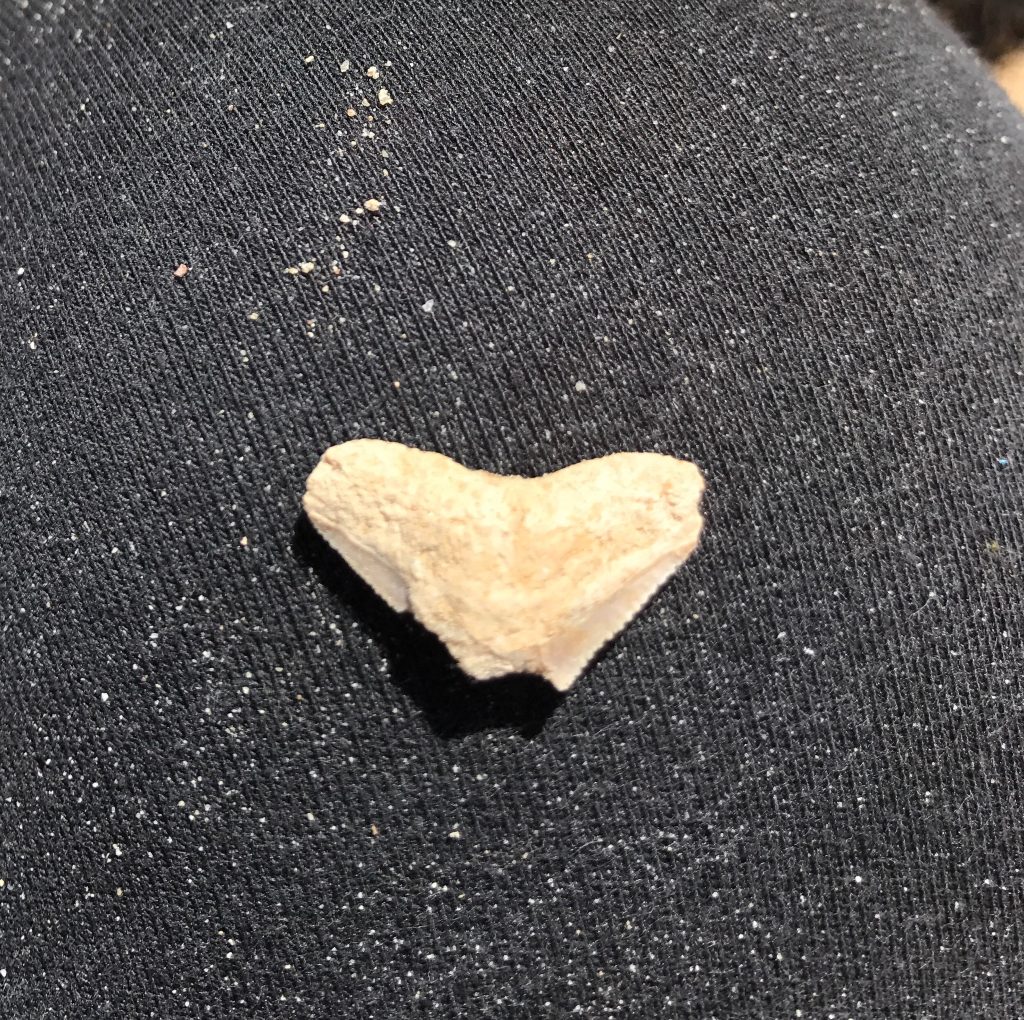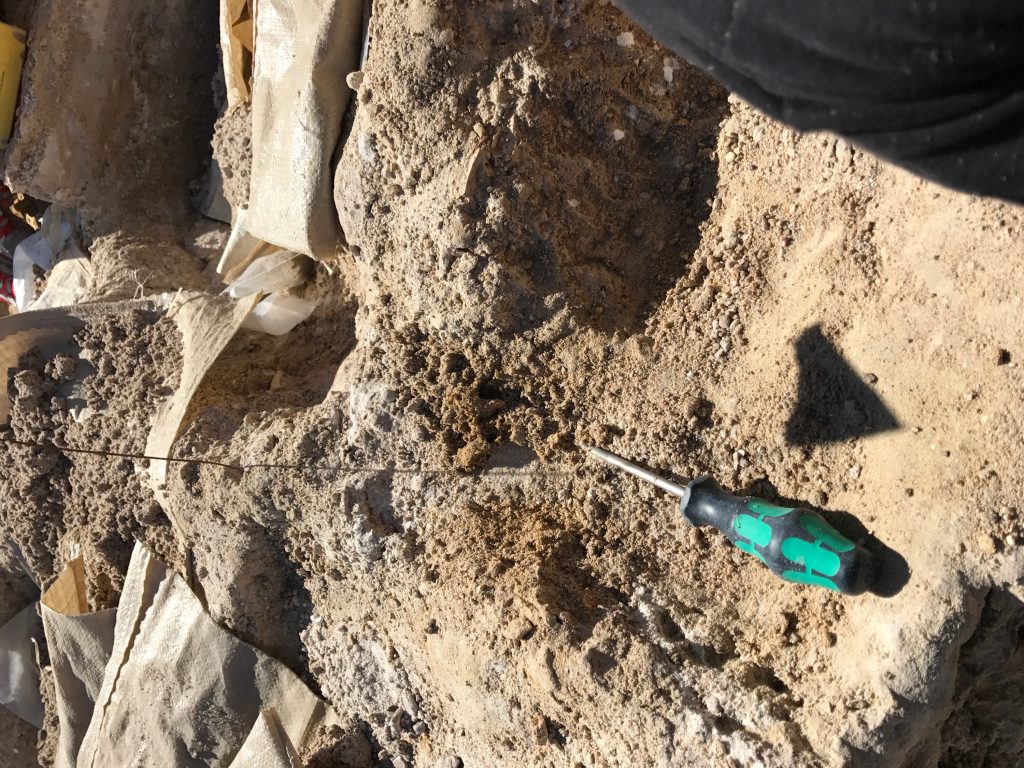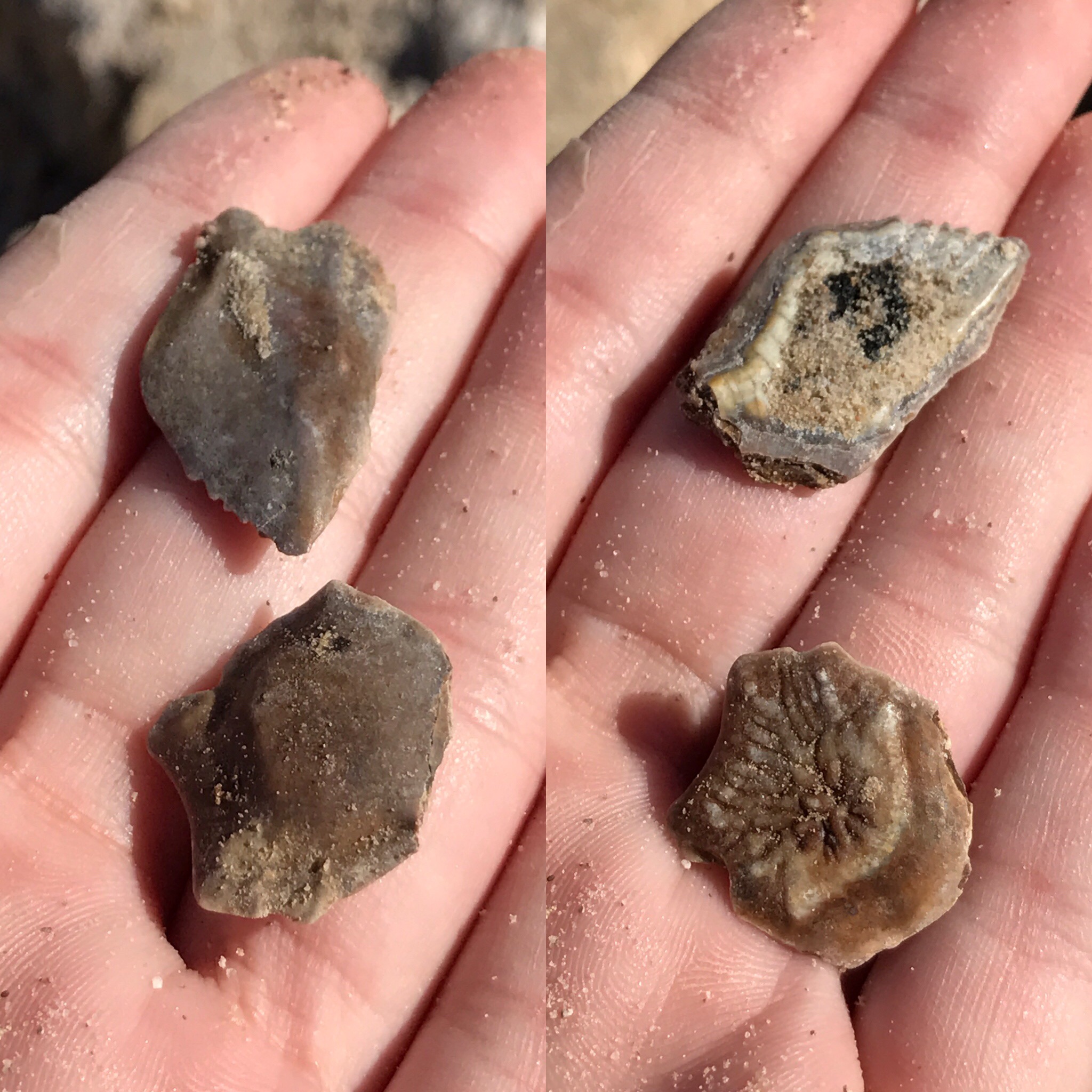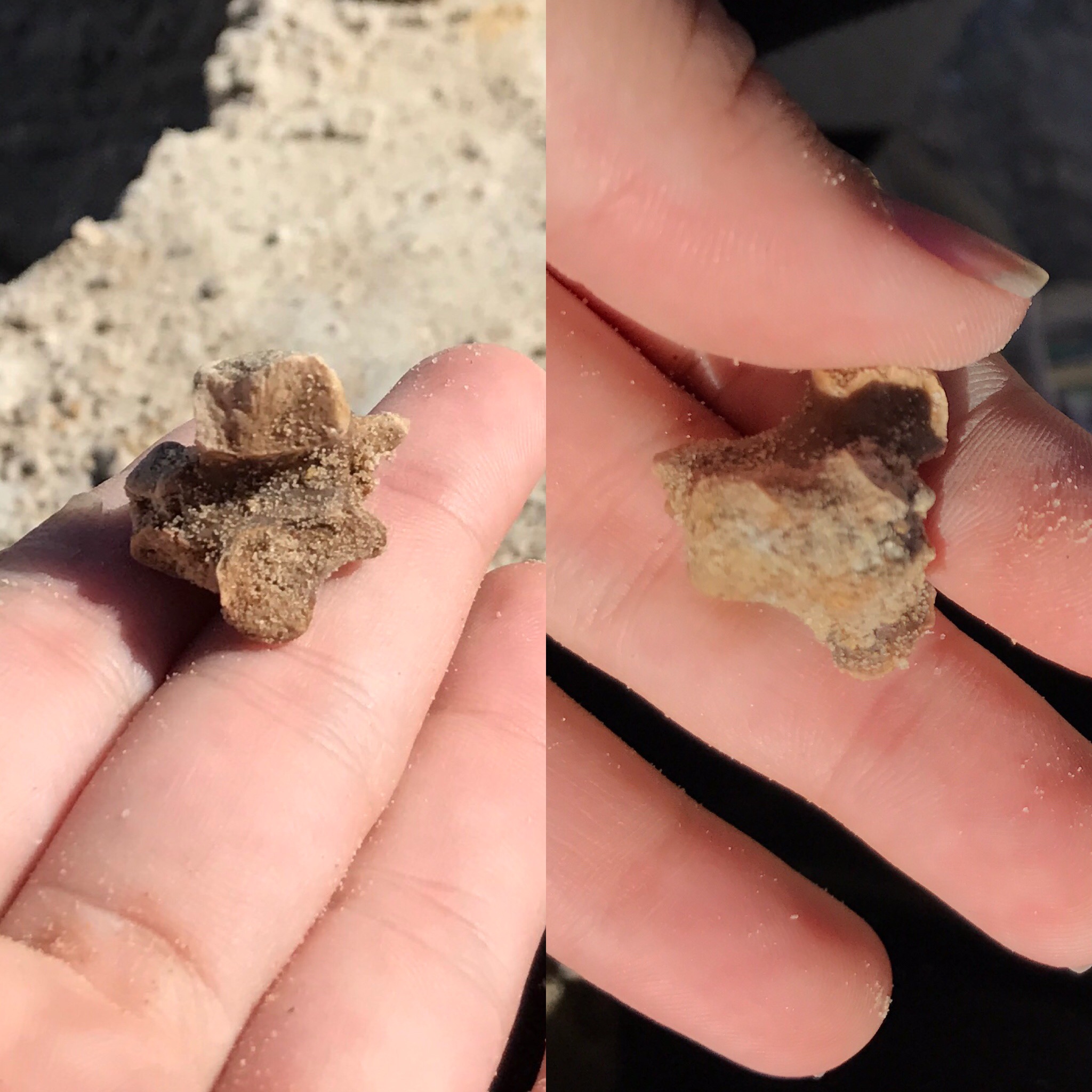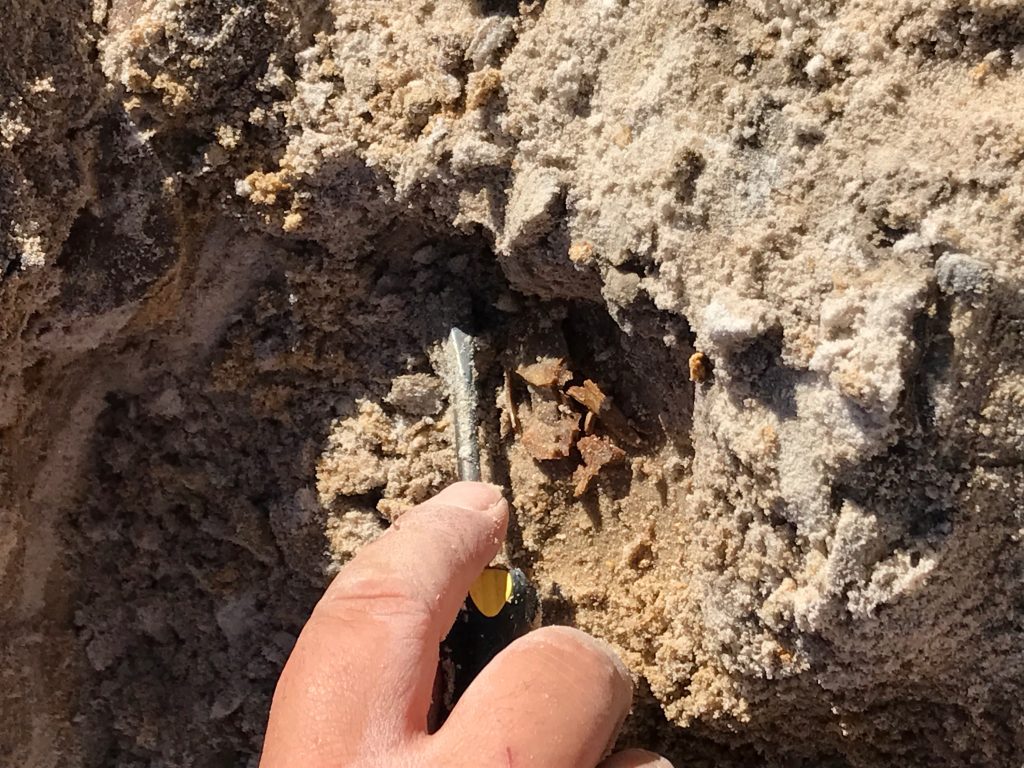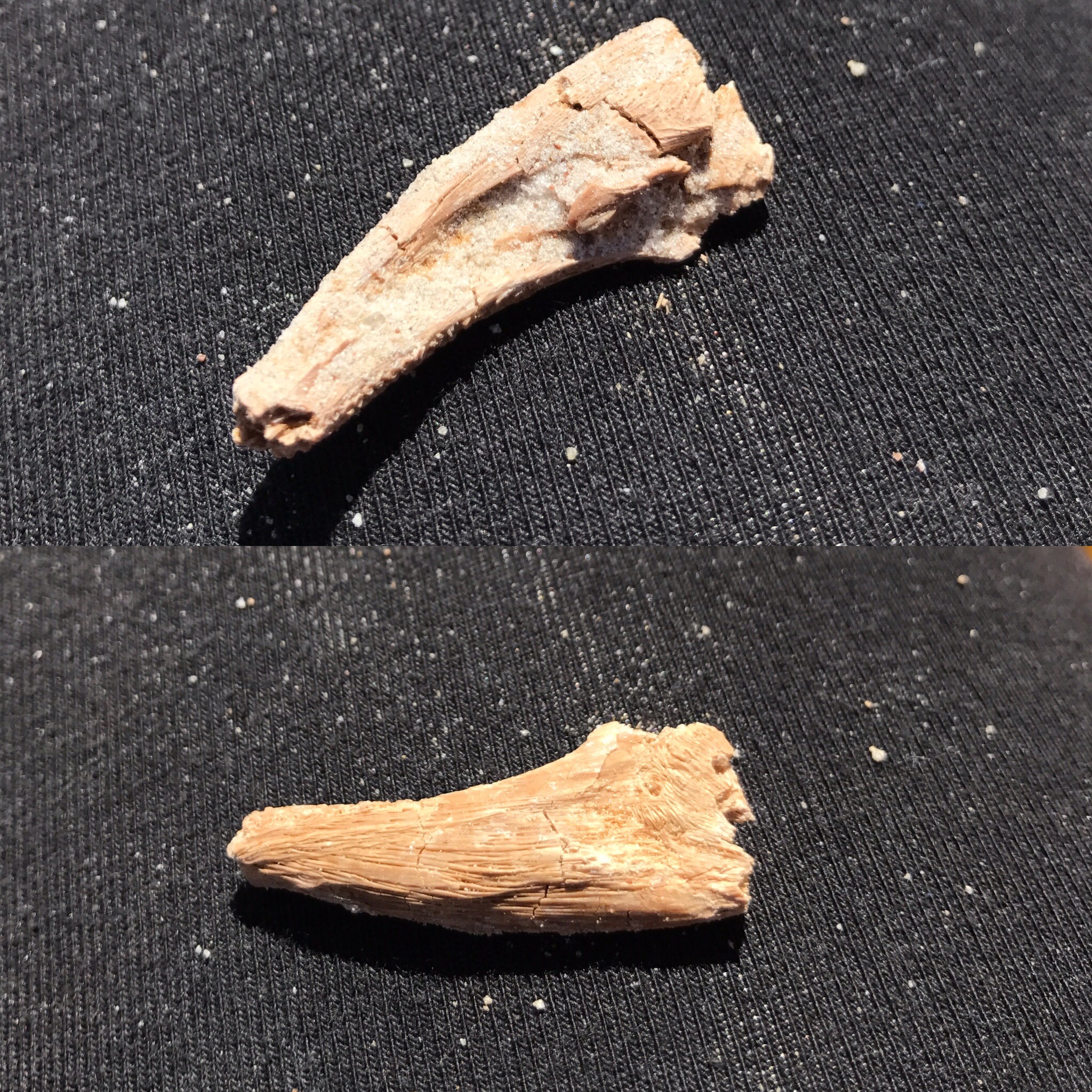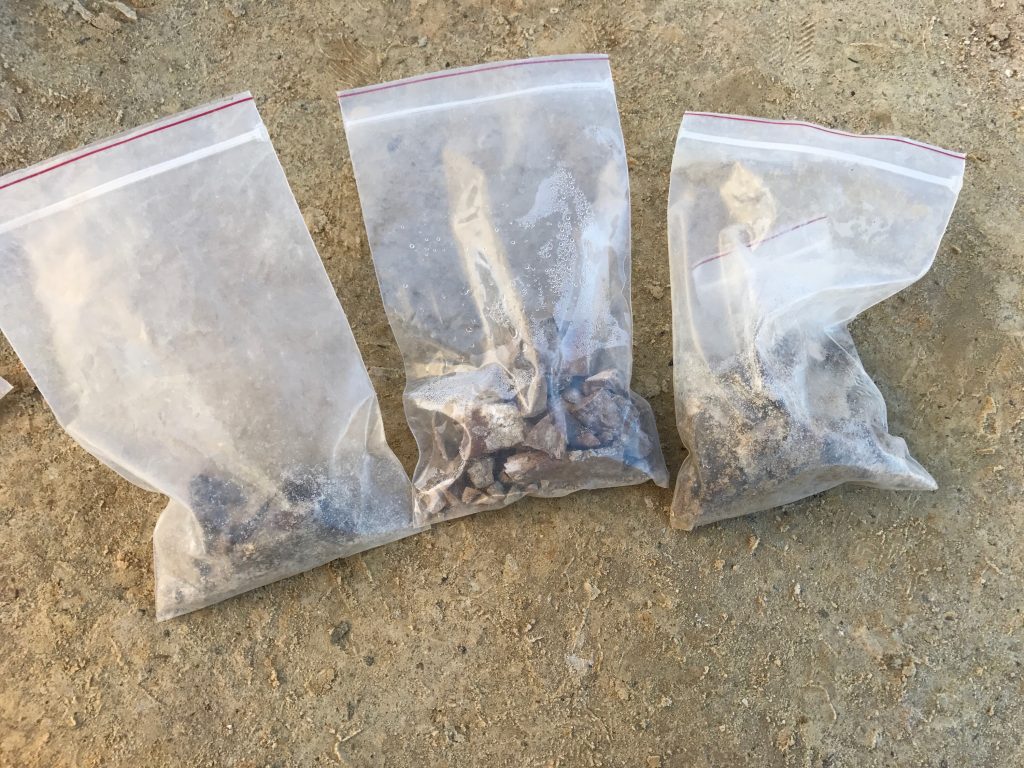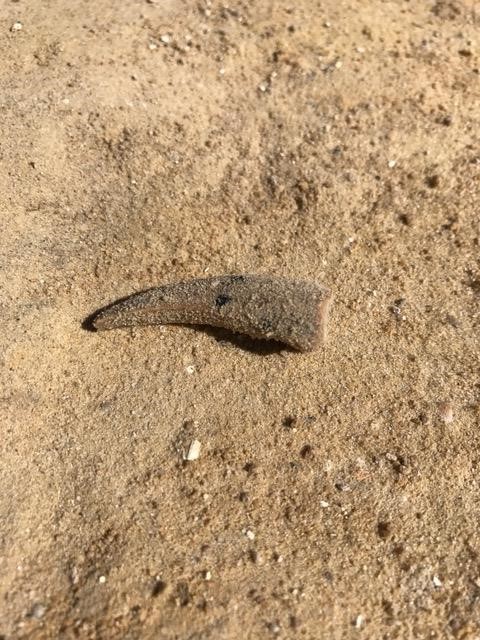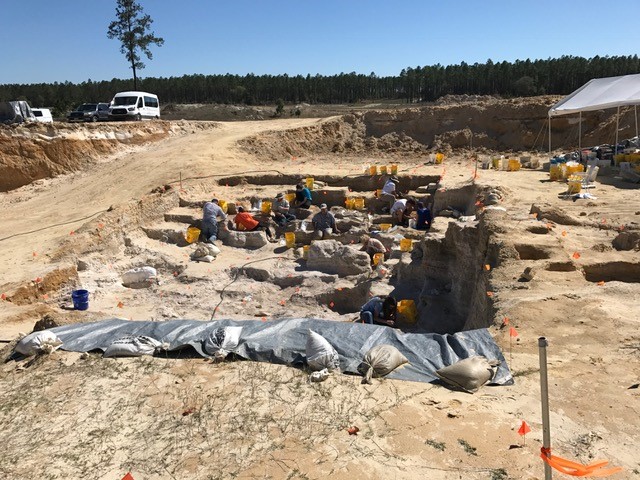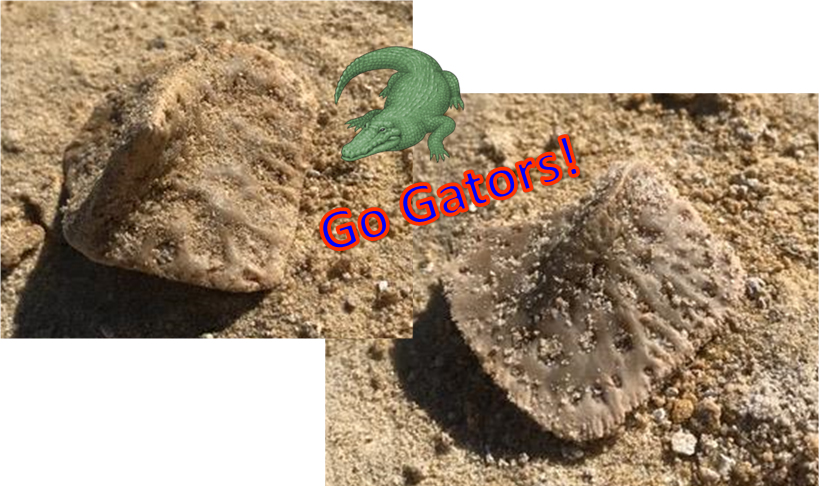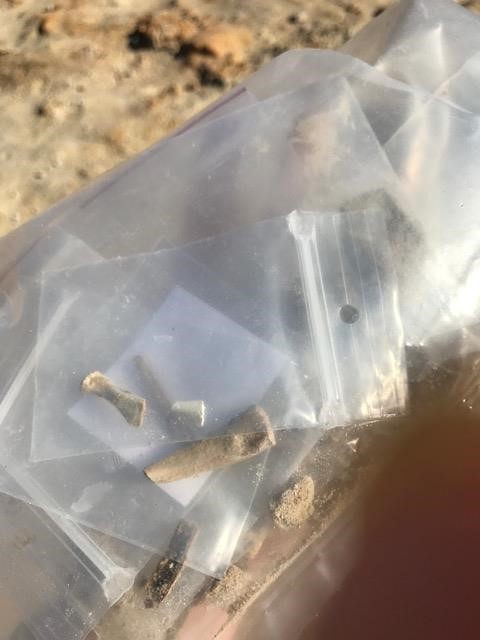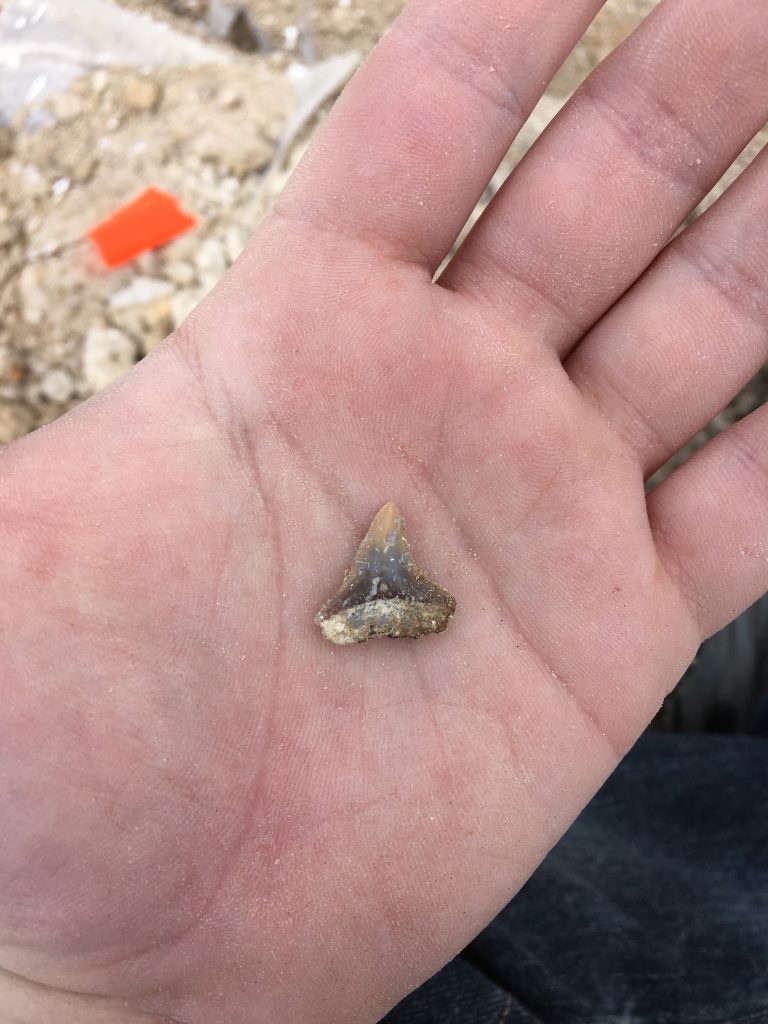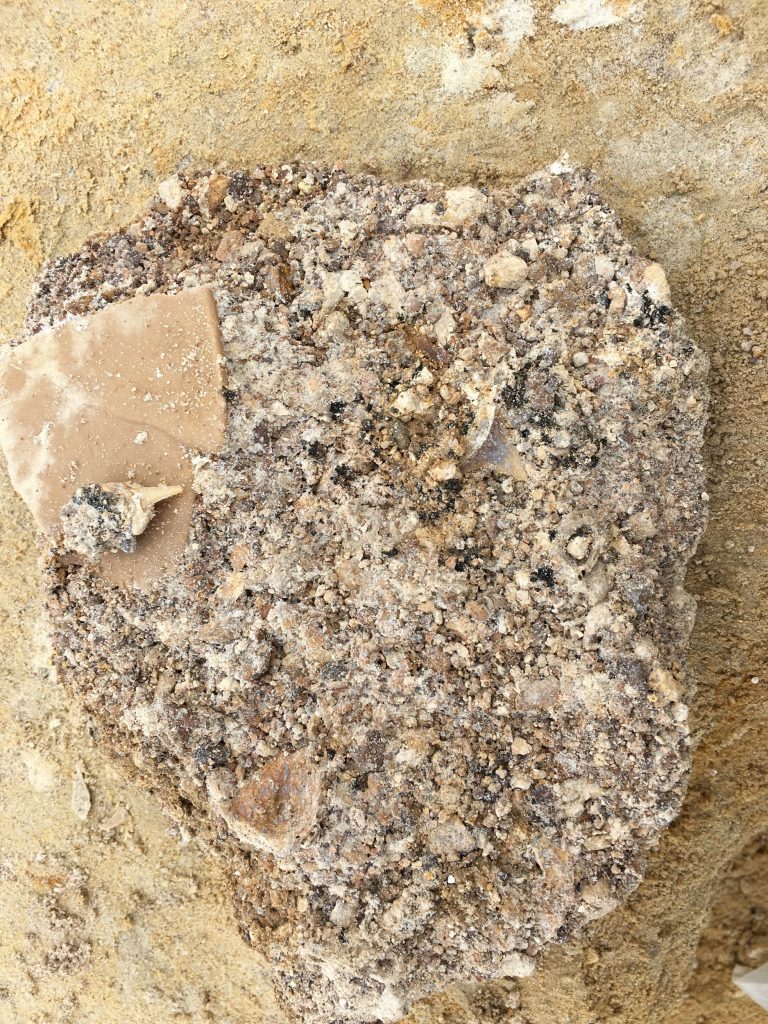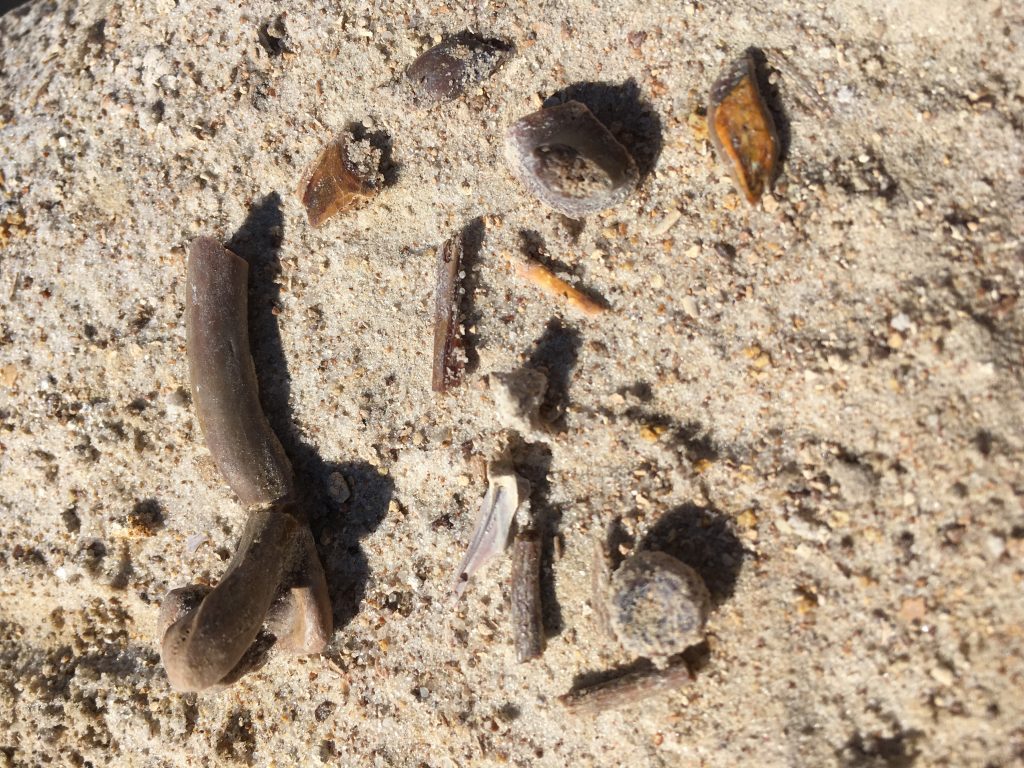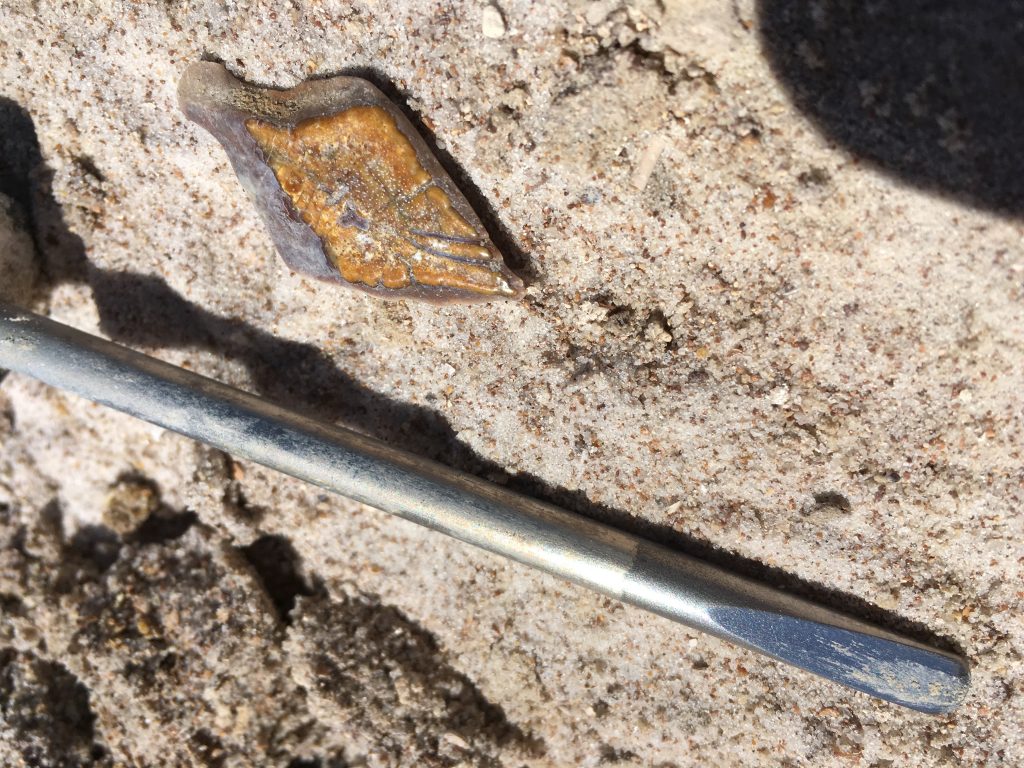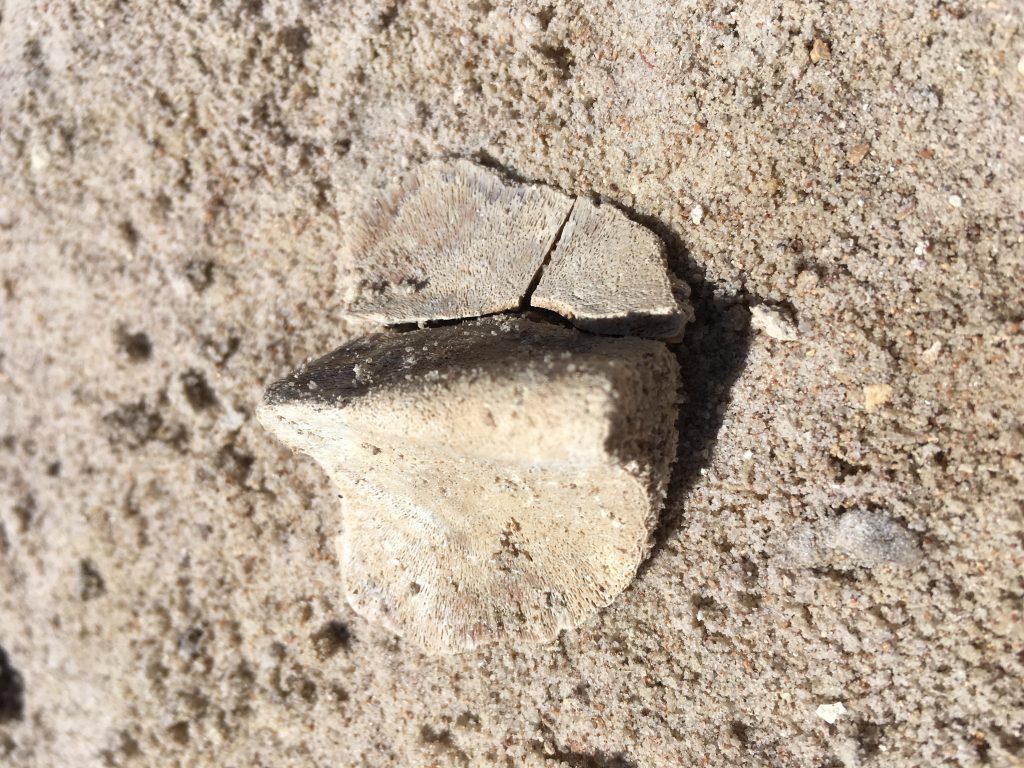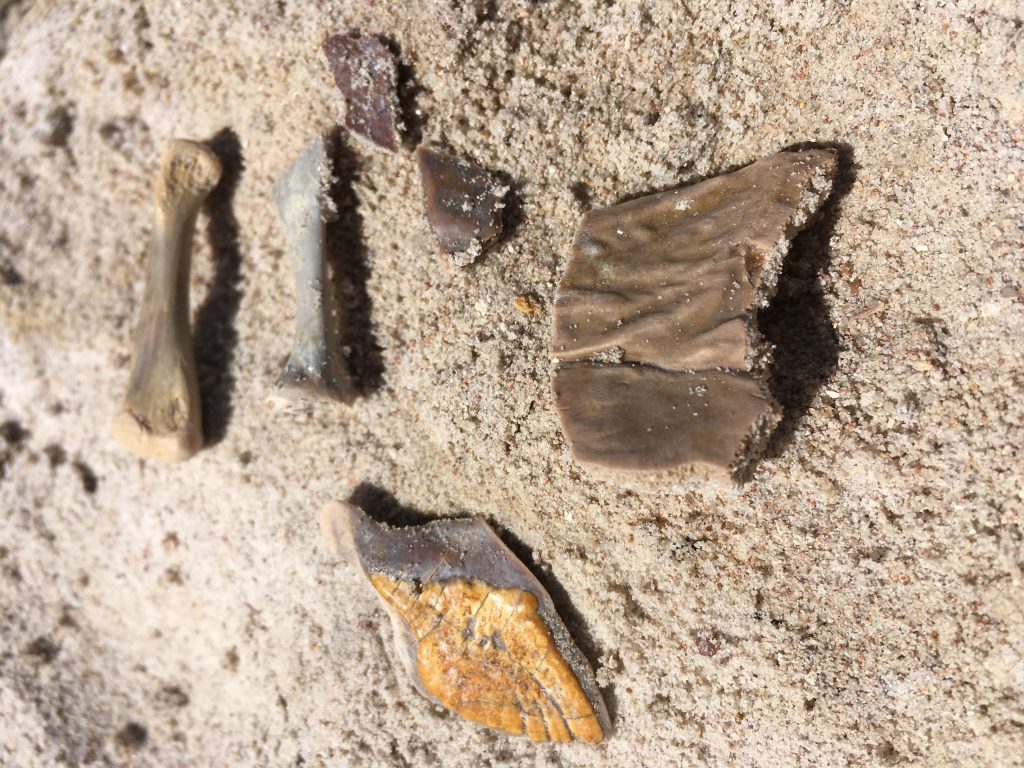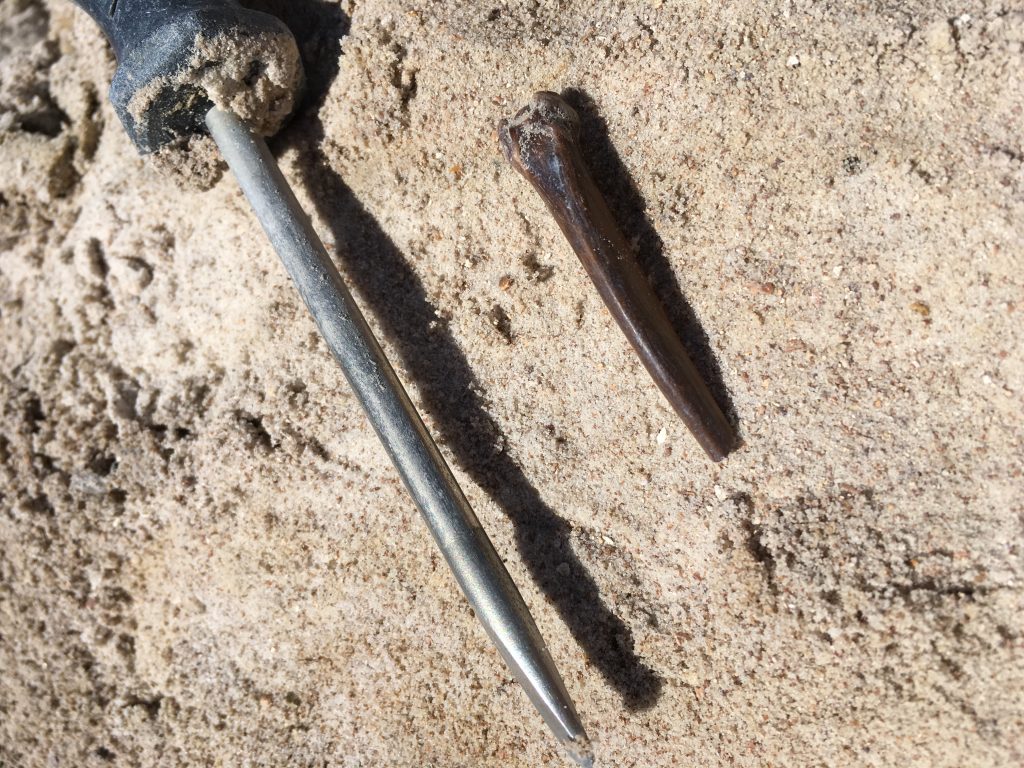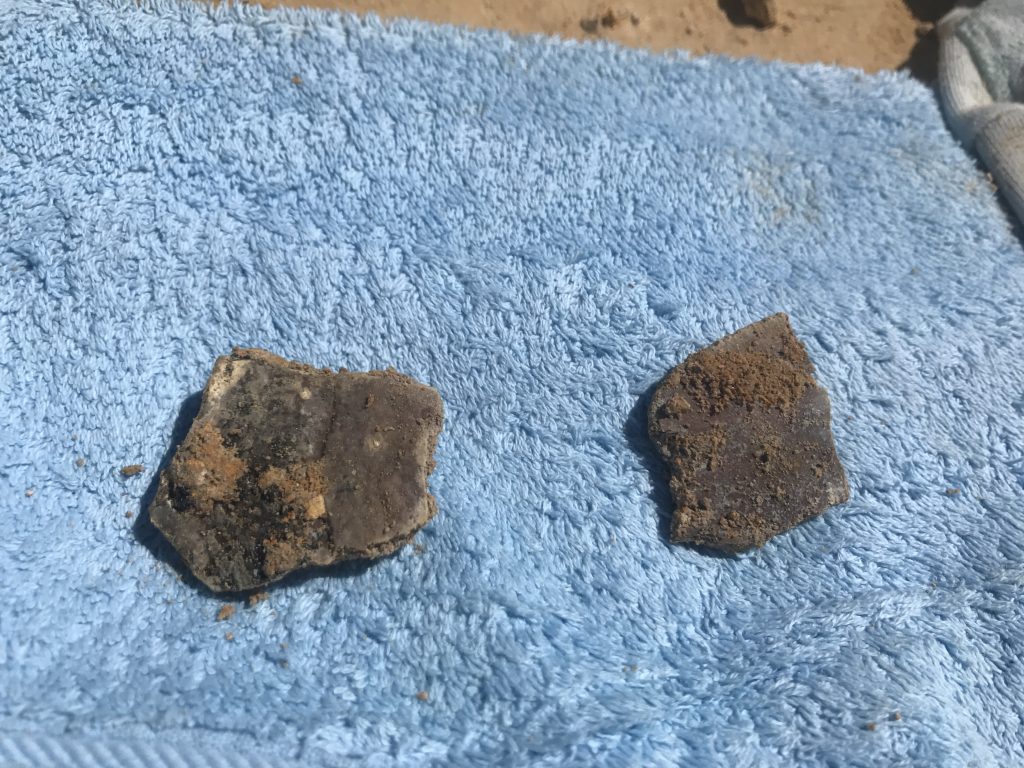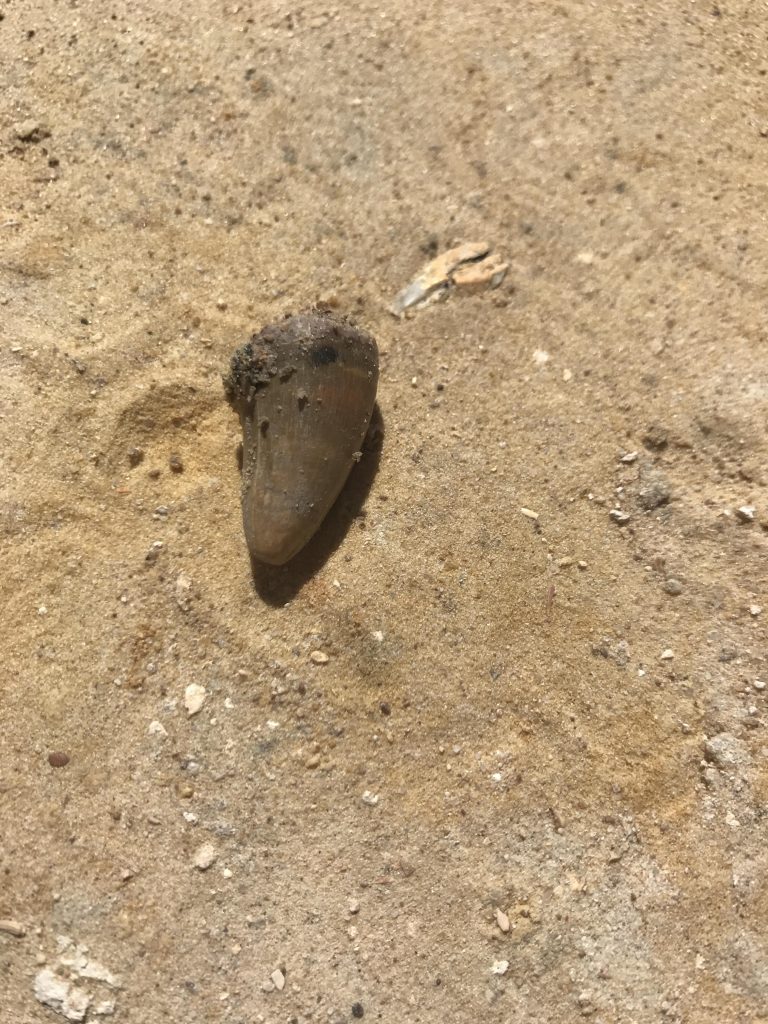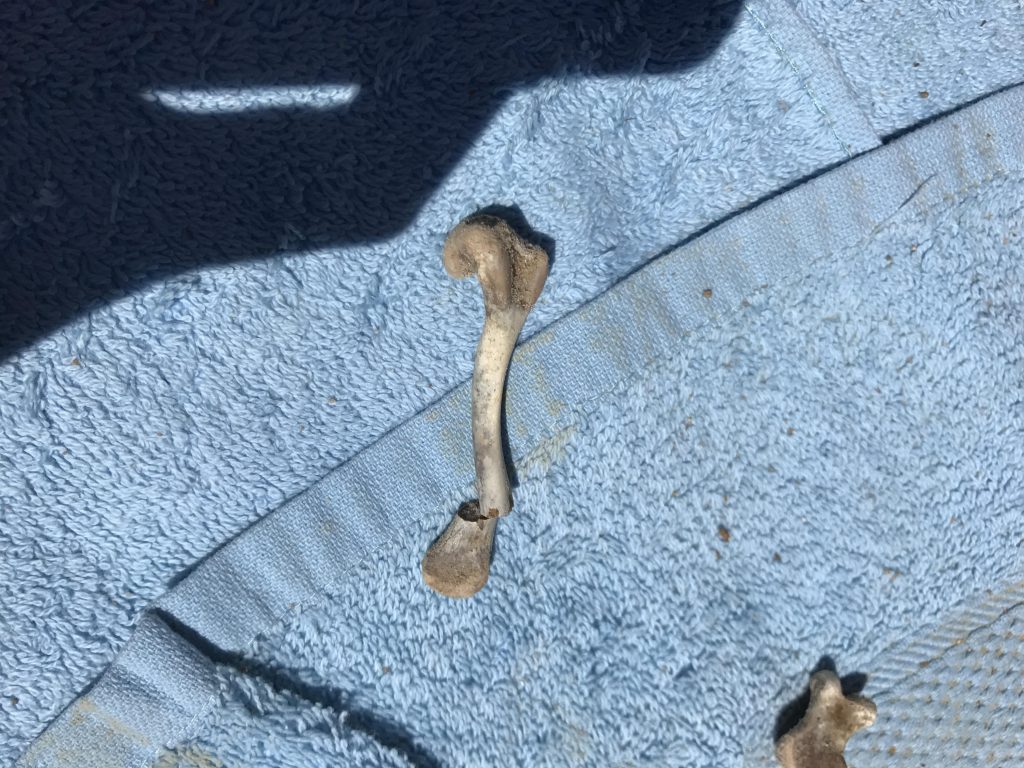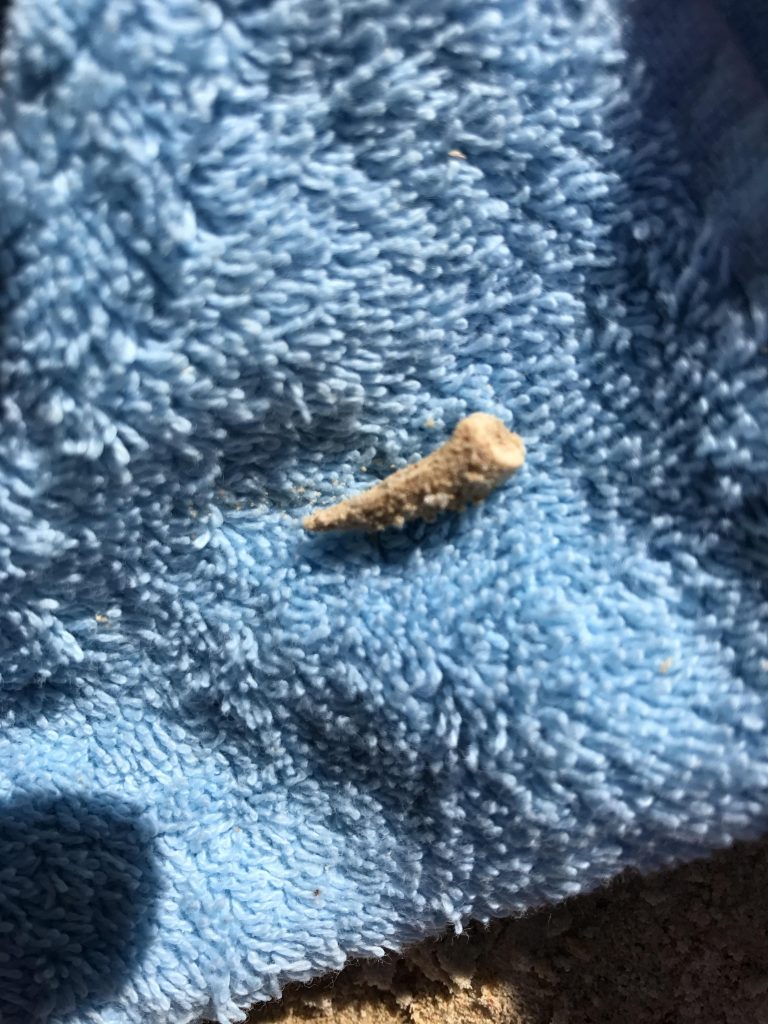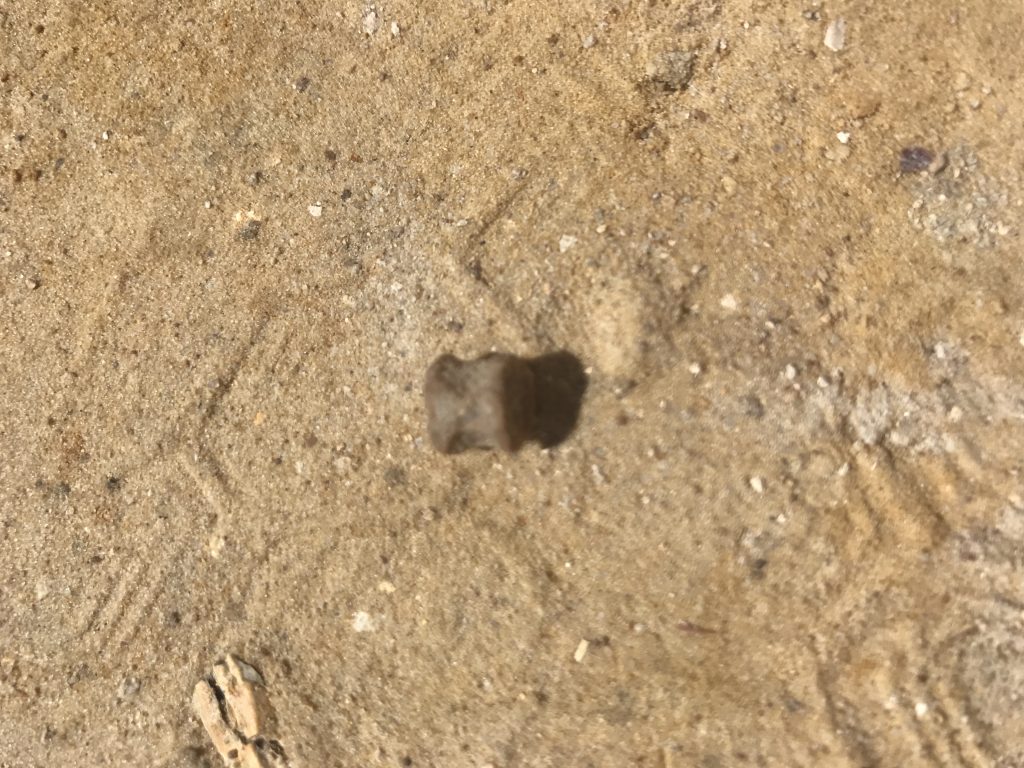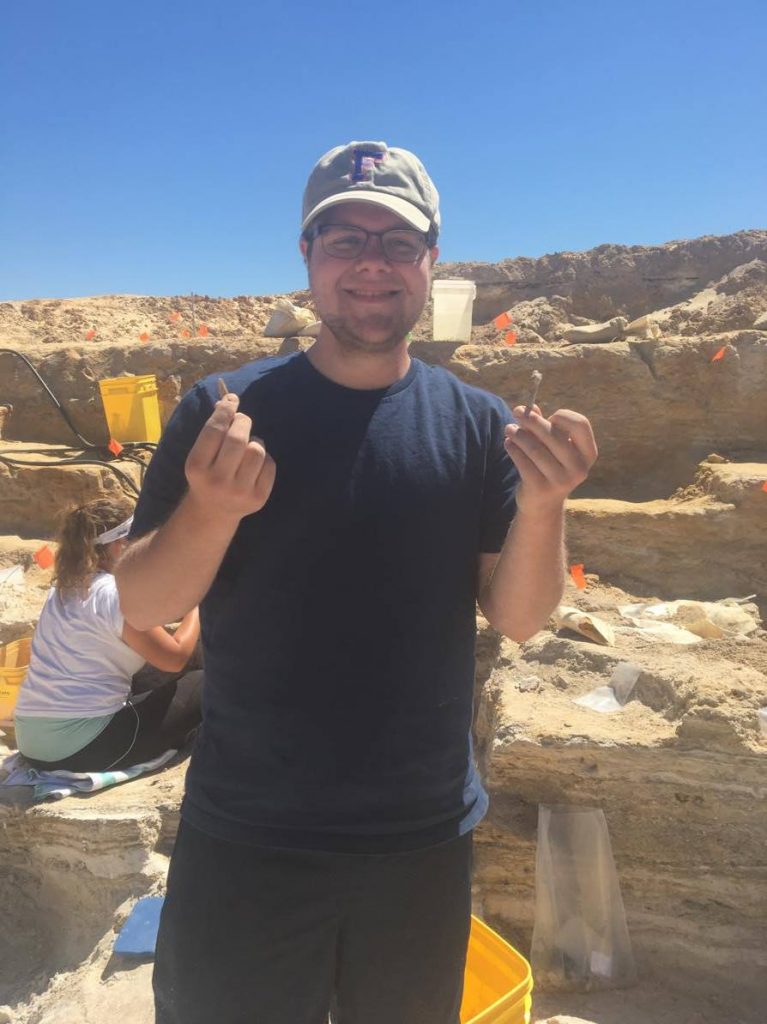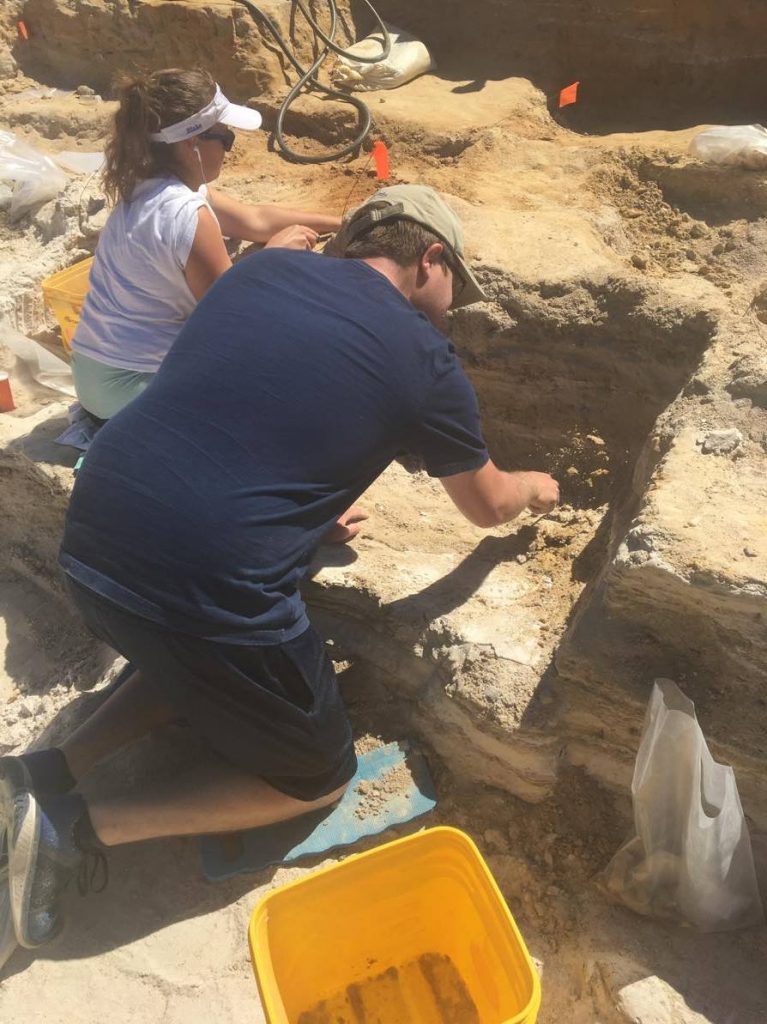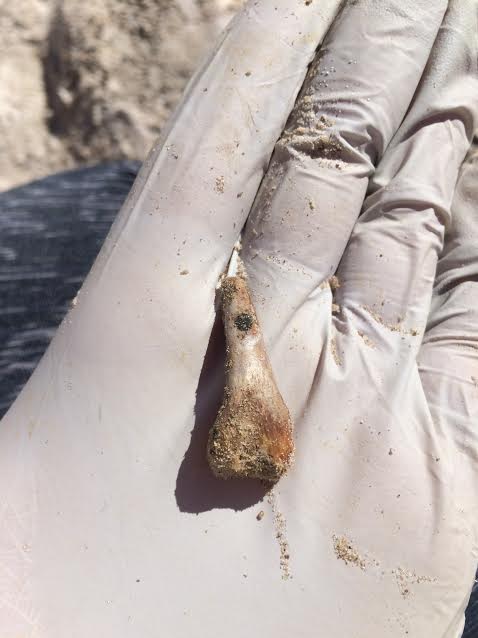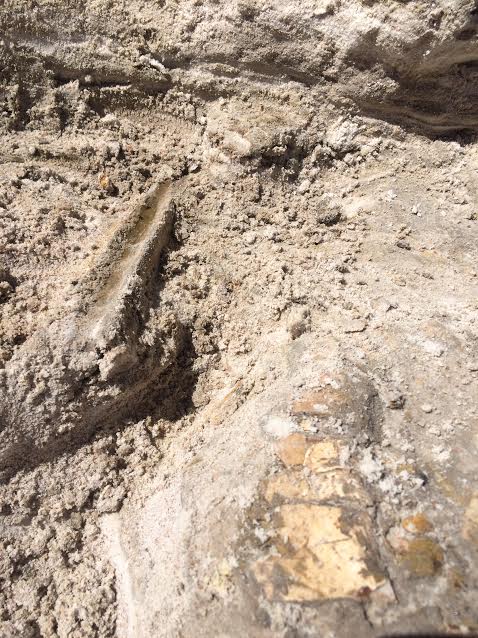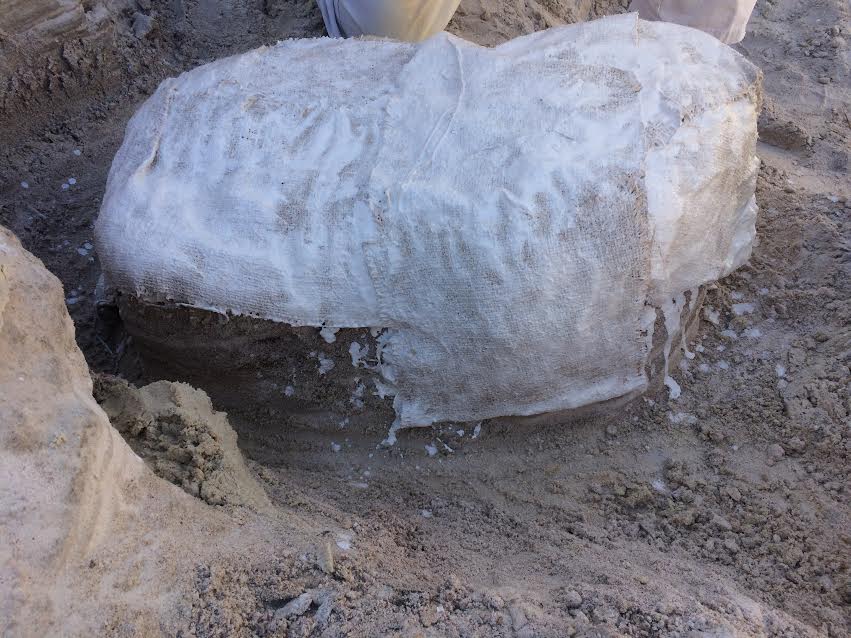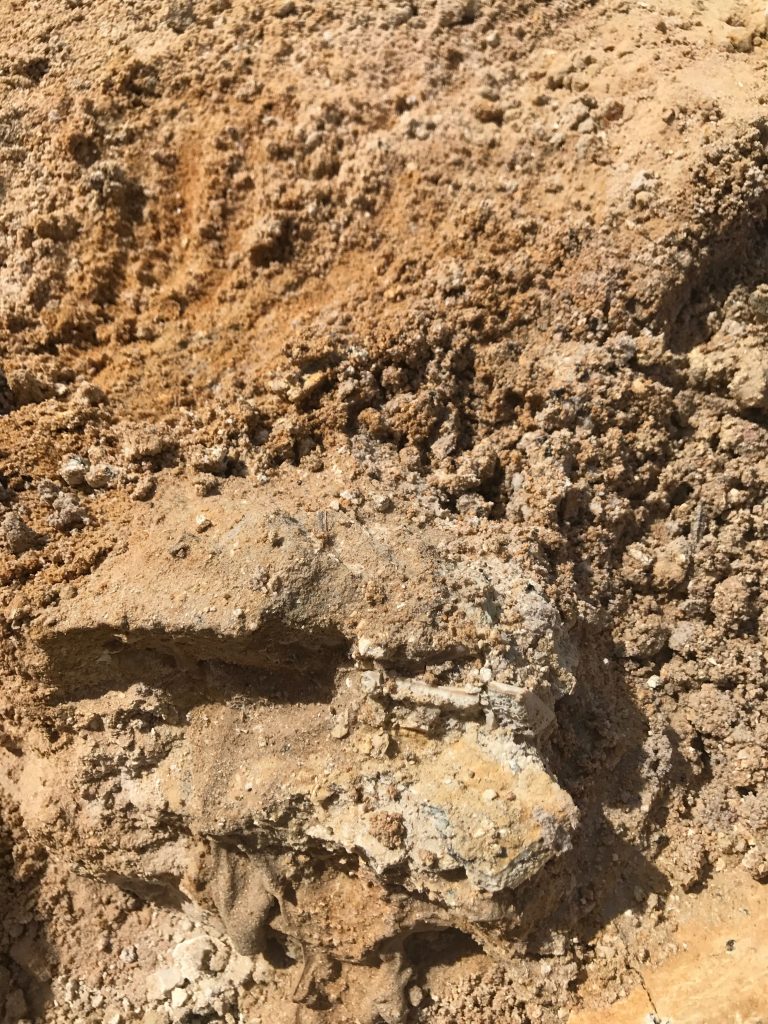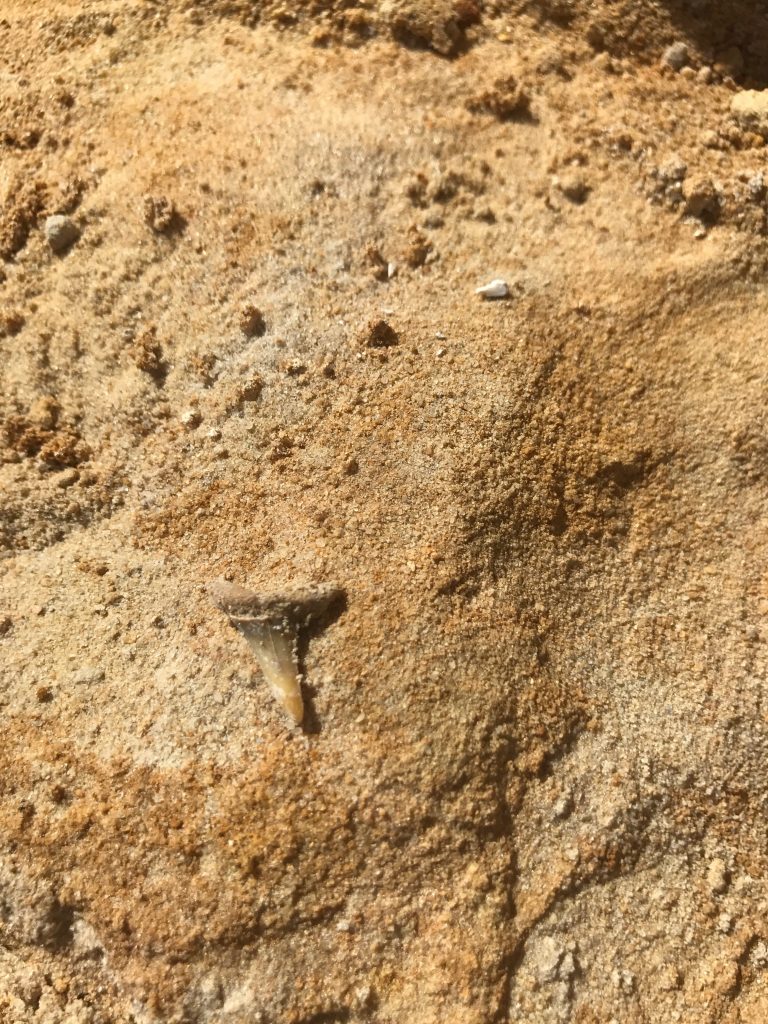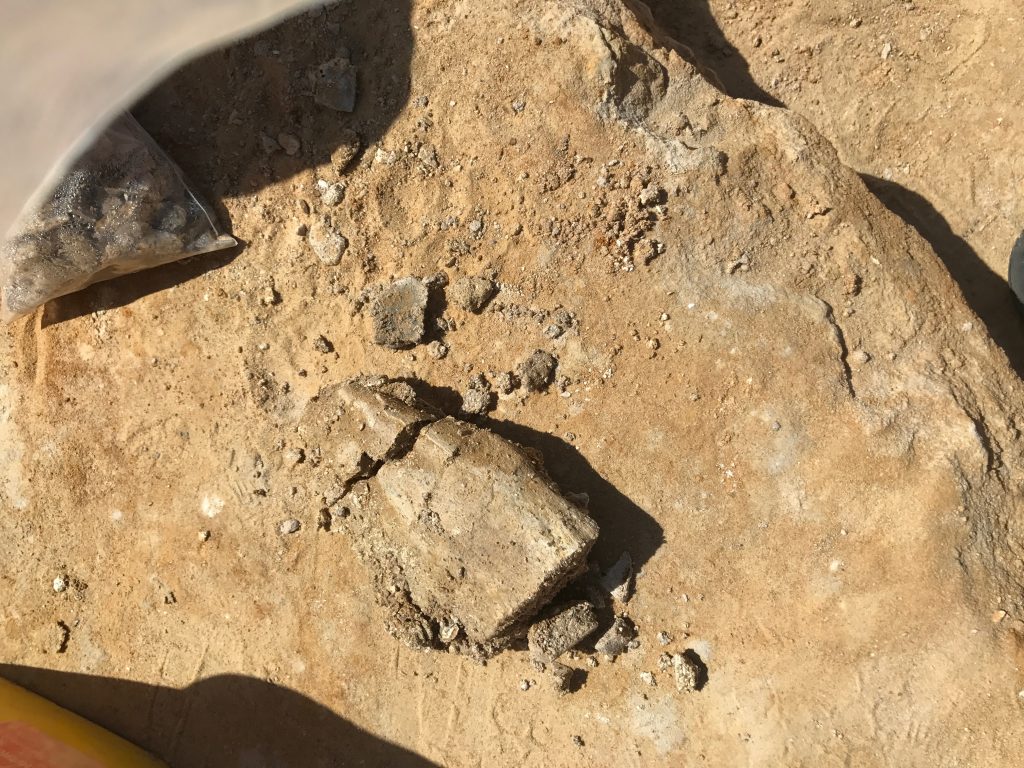Follow University of Florida students enrolled in the Topics in Field Geology – Florida Vertebrate Paleontology course through their first, second, and now third impressions of taking part in a paleontological dig at the Montbrook Fossil Site.
Sunday, February 26, 2017
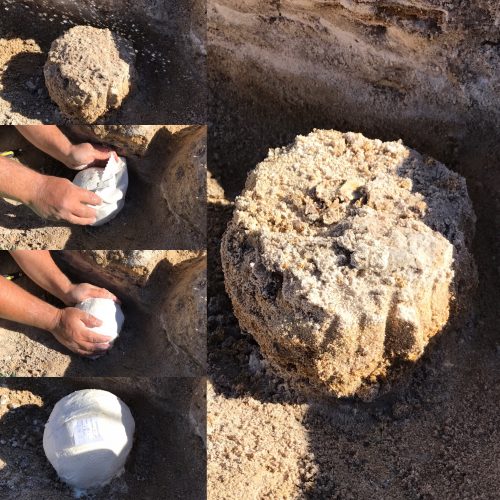
“Today was my third fossil dig. I once again returned to the “turtle death layer” aka 2A, but was located a bit lower than my last spot. I was given the assignment of continuing to dig a trench around a large turtle shell that straddled my square and the square next to it. I found this mission to be quite tedious as I constantly ran into hard or sharp objects that I then had to sift through carefully to check for fossils. My day basically became one big game of “is that a bone or a rock?”
“One thing that was very interesting to learn about today was plaster jacketing.In the square next to me, Dr. Bloch uncovered a very fragile fish skull. This was the first plaster jacket of the day. In a square behind me, another volunteer was able to plaster jacket a gomphothere vertebra. This was a huge part of finally starting to remove the large gomphothere pieces that have sat in the middle of the site for quite some time now.
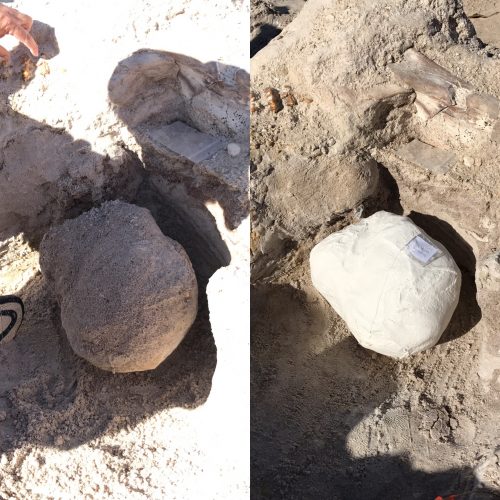
“As I continued to dig my trench and uncover countless turtle fossils, Dr. Bloch continued to quickly move through his square towards mine. Only about an inch left until he hit my square, Dr. Bloch uncovered a turtle skull! Although this was not in my square, I was able to help him plaster jacket the fossil, which apparently was a unique find! The process of plaster jacketing includes digging a trench around the fossil to place it on a sort of pedestal. Then, putting fine sand on top of the fossil, followed by water, then sand, then water, and so on, until the fossil has a nice “cushion” on top of it. You then proceed by utilizing gauze-like bandages and a plaster solution to cover over your fossil “sand castle.”
“You must be careful to do this neatly and smooth out each piece of bandage. The plaster jacket then gets topped off with a label and is left to dry. Once dried, a trowel or shovel can be used to dig underneath the entire thing and remove it from the ground! Learning about plaster jacketing and seeing all the neat things that other people found today still made the day very much worth it. Of my own finds, I managed to find a partial shark’s tooth, a fish jaw bone, some gar scales, numerous pieces of turtle shell and some turtle vertebrae!” – Blake Meyer
“My third dig was not as eventful as my last but much more productive than the first. This time, I was leveling out a square in the “turtle death” layer, so I found lots of little turtle parts and other small bones. My finds of the day were two alligator osteoderms and a big alligator snapping turtle claw, which was a new find for me. I didn’t find any more shark teeth, which was disappointing, or a saber tooth cat skull, more so disappointing. We have two more scheduled digs left, but I think I will continue to volunteer after the class is done.” – Storm Wittenberg
Sunday, February 12th
“My biggest find of last trip was alligator snapping turtle shell, but it was large enough that I left it alone for the experts to extract.
“When I first started digging, the upper layers practically peeled off in chunks. If they were flipped over, the undersides were covered in fossils. Below is the largest piece I managed to break off – it had turtle shell fragments, a sand tiger shark tooth, and a bull shark tooth, plus some other goodies.
“Farther down, it was a pretty gator-filled day. Dug up at least four osteoderms (the bone armor plates that cover a gator’s back). Besides that, also helped to load up a plaster-covered Rhynchotherium ribcage in the van. They are not lightweight.” – Ben Rumsey
Saturday, March 18
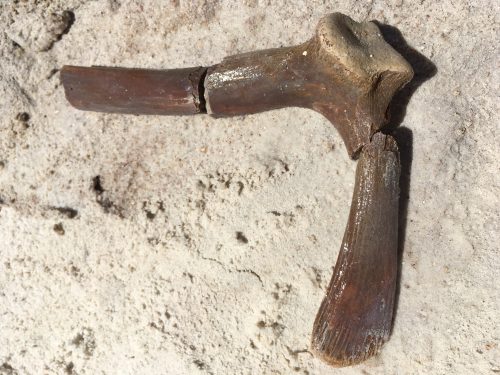
“Today was a day of large. The phrase “The largest I’ve found yet!” was repeated throughout the dig. The largest drum spine, the largest gar scales, the largest (snapping turtle) scapula, the largest fish vertebra, the largest amount of alligator foot bones I’ve gotten in one day, the largest amount of super soft sand in half of my grid square that had absolutely nothing in it in the way of fossils. With that last point being said however, hauling 12 buckets of sand and other media away from your square throughout the day gets to be a great workout! It was also very rewarding to see my square lowered by at least 12 inches! Other finds included an immature Gomphothere tarsal bone, an alligator osteoderm, and various turtle fragments! Thanks as well to Trey and his support team for an excellent cake and even better conversation!” – Erich Zellmer
Sunday, March 19
“My third day at the Montbrook site was again a unique experience, different even from my first two dig days. I was placed in a square that I was told could be the most uneven one at the site. My job was to try and level it out as much as possible. However, the spot had not been touched in a while and was very dry, making this task a little more difficult. Throughout the day, I had the hose by my side and would have to soak the sediment as I went along. Though this could be tedious, it was great because this allowed me to find smaller fossils that I might have missed had the ground been dry.
“This day at the site was also different because I was able to find a lot more fossils than I previously have, and they were also more diverse. My first day I was in a plot that had no fossils, I was instructed to try and remove as much sediment as I could as fast as possible and that I shouldn’t expect to find anything. My second day I found mostly turtle shell pieces and alligator osteoderms. However this time, I found a large alligator tooth, two snapping turtle femurs, large pieces of turtle shell, a fish vertebra, and so much more. Overall, digging at the Montbrook site is a wonderful experience and I would recommend it to anyone who asked!” – Nicole Welton
“I went on my second and third dig days this past weekend with high expectations because my first dig day had gone really well. I can say that I definitely wasn’t disappointed. On both days I seemed to be pulling fossils out of the ground left and right. Some of them were really awesome like the alligator claw I found on the first day. The women who was next to me, who I think is a graduate student studying paleontology, found this really cool set of three shark teeth.
“Also, throughout both days Dr. Hulbert gladly answered everyone’s questions and since the dig site is kind of a bit cozy everyone got a chance to learn. I think that aspect is my favorite part of going on these digs. Being able to go out there, find a fossil, and then be able to ask some questions based on what I find. This results in being able to learn lots of information while having a feeling of excitement about what exactly you’re going to find next. Another great thing was being able to observe the plaster jacket process again because it had been a minute since my last dig day. I am really considering coming back even after the course ends for a few weekends out of the summer.” – Justin Farley
“Another beautiful day at the Montbrook fossil digging site. Unfortunately, for the first time I didn’t get to see the free-roaming cows that usually surround the area. Regardless, it was a sunny and beautiful day for fossil digging. I was able to dig in a square that was lower down in the pit. There was part of what appeared to be a full turtle fossil located in the section next to me quite a few layers down. I started off the day with the task of lowering my section in order to see the extent of the fossil. Initially I thought this task would account for only the first portion of my day. However, it turned into a full day affair. As I leveled off my section and dug to reach the turtle shell, I encountered many fish vertebrae and other miscellaneous fossils. Once I finally reached the full turtle shell, I nearly dug out the entire perimeter, but then came across more fossil. There appeared to be a second turtle shell directly below the first one. After a full day of digging, I created a perimeter around two touching and almost complete turtle shells with a gomphothere fossil lodged next to one of the shells. Luckily, I was able to dig out this perimeter in time to make my first plaster jacket! I’ve always wanted to be able to make a plaster jacket and it was exhilarating to finally unearth the fossils to do so. Every time I visit the site, I am continually amazed at how enchanting the fossil digging experience can be.” – Kelsea Rose
Sunday, March 26th
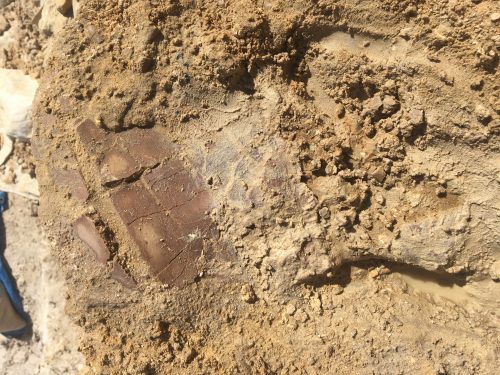
“This past Sunday, I got another chance to visit the fossil digging site for a morning half day! Today I dug up in a higher area than I have been both of my previous visits, and was assigned with just clearing away some of the dirt and to look for fossils. This was different from past times, as I didn’t have a clear goal in mind such as working on a certain fossil. However, it proved to be just as interesting, and with the help of a hose to loosen some of the soil I was able to make a lot of progress in my square.
“Unfortunately, I did not find too much in my area, but halfway through a partner and I switched squares and I worked on excavating a turtle fossil that she had been working on. After some work, I was able to successfully get it out of the ground! This was one of the biggest parts of a turtle shell that I had found and I kept finding more pieces as I was digging around it! I have to say, though, it was definitely more hot in the higher areas of the site, I’ll be making sure to bring a hat next time!” – Charlie Bisbee
“I did a half day today and only was at the site for a few hours, but I found a lot of fossils in the little time I was there. The site was a lot quieter today because there were very few volunteers there and it was much warmer than the last two dig dates I attended. I dug up the majority of the bottom of a turtle shell but unfortunately it broke apart during removal. I also found part of a snapping turtle shell nearby. I had never worked on one of the upper areas before and it was interesting to compare the difference in the dirt. I had to continuously water the area because the dirt was so dry and it was difficult to remove the pieces of shell. Before we left we lifted an extremely heavy plaster jacket into the van. It contained the jawbones of a young gomphothere.” – Monica Sciturro
Sunday, April 2nd
“Today was a productive day! I dove deep into the turtle death zone. I uncovered more fossil today than I had over the course of me volunteering here. I found fragments of many sliding, and soft shell turtles along with three large segments of snapping turtle shells. Not only did I excavate turtles, but I also found a handful of alligator osteoderms and a shark’s tooth.” – William Annis
“This was one of my most eventful digs! I found almost no turtle shells which at this point is a highlight for me after only seeing turtle shells and clay for the past few digs. I came across some cool alligator vertebrae and other related fossils. I realized that I really enjoy the feeling of uncovering a piece of bone in the clay or sand especially if it is one that I have to dig around and slowly uncover because it is larger or more complete. I had quite a few of these experiences on this day and it was a great time! On a different note, I ended up with a very bad sunburn on my back so I should remember to pack on the sunscreen at my next dig!” – Estefania Melo
Want more? Click for the students second to last impressions of digging at the Montbrook Fossil site.
